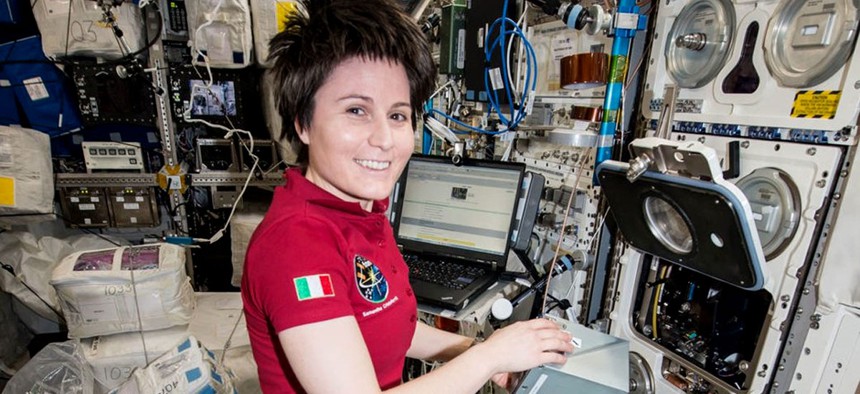The Internet in Space? Slow as Dial-Up

Astronaut Samantha Cristoforetti prepares an experiment on SpaceX's Dragon cargo craft. European Space Agency
Astronauts gripe that connectivity is “very slow,” but that could change with laser-based data transmission NASA has already tested.
Outer space has its perks. But super-speedy Internet is, so far, not one of them.
Connection speeds from the International Space Station are “worse than what dial-up was like,” the astronaut Scott Kelly said on Twitter. (His colleague, Reid Wiseman, agrees: “We have a very slow Internet connection, but reliable email,” he said back in February.)
Internet connectivity in space is structured around a network of tracking and data relay satellites—the same fleet of communications satellites that NASA engineers on the ground use to communicate with astronauts on the International Space Station. And it's not like there's any shortage of technology aboard.
“They have laptop computers, including one in their personal sleeping quarters, which they can use for limited web access—email, tweeting, and news,” David Steitz, a spokesman for NASA, told me. “They also have tablets onboard they can use for various operational tasks, but also video conferences with family and friends on the ground.”
Astronauts first got Internet access five years ago, a move that NASA said would help improve their quality of life and help them feel less isolated in space.
What makes the connection so slow compared with broadband Internet speed on the ground? The easiest way to understand it is to consider the distance that data has to travel. When an astronaut clicks a link on a website in space, that request first travels 22,000 miles away from Earth, to a network of geosynchronous satellites far beyond the relatively close station. The satellites then send the signal down to a receiver on the ground below, which processes the request before returning the response along the same path.
Another way to think about the Internet connection from space is as “remote access to the Internet via a ground computer,” as NASA once explained. Or, as one Redditor put it in a discussion of the Internet connection: “The ping is quite high because of the satellite transmission to earth, but the bandwidth isn't too terrible.” So the capacity for data transmission is robust, but the time it takes to transmit is—by an Earthling’s standards—pretty slow.
To get online, astronauts are plugging into the same channel that’s used for all kinds of commands to the International Space Station.
“It's the satellite constellation that we use for all of our spacecraft operations,” said Dan Huot, a spokesman for NASA. “It’s used for a number of things—not only their Internet access but any telemetry, basically any data from spacecraft systems going up to the station or coming down.”
So when the crew on the International Space Station wants to tweak the thermostat or boost its altitude, all of that work is done by an engineer on the ground.
“We use our uplink through these satellites to send those commands,” Huot said, “and using the same channels, basically, we've enabled them with Internet access.”
A temperature change is a straightforward enough command that it’s basically “instantaneous,” Huot says. And while Internet speeds may be slower than that, they’re not exactly terrible.
“They have decent speeds,” he said. “We have the capability to send up and down large-format video files. We’re sending gigs and gigs and gigs of video every single day just from live downlinks of the crews themselves. [...] We have bandwidth to send that down to the ground without overloading the system.”
“In their off-duty time, they do have the capability to watch live television shows, and live sports,” Huot said.
Astronauts even watch movies in space, though they aren’t relying on Netflix to do so.
“The astronauts can pick, before they fly, anything they want to watch up there,” he said. “They actually have a projector and a screen they can use to watch movies.” (He declined to share which films are on the current rotation, but astronauts said they watched Gravity and Star Wars from space in recent months.) Livestream video is possible on the International Space Station—of course, there are limitations other than connection times.
“It's still basically a work network,” Huot said. “So it’s not totally unfiltered access to the Internet.”
Either way, Internet connectivity is likely to improve for astronauts as NASA makes the switch to laser-based systems. Already, engineers have transmitted a high-definition video from the International Space Station to the ground on a laser beam. It's a “much faster” way to transmit data, NASA said in a demonstration, and one that hints at the “future of communications to and from space.”





